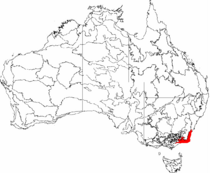Thaua facts for kids
The Thaua (also spelled Thawa or Dhawa) were an Aboriginal Australian group of people. They lived along the South Coast of New South Wales, especially around the Twofold Bay area. They are also sometimes called Yuin-Djuin.
Quick facts for kids Thaua people |
|
|---|---|

South east corner bioregion
|
|
| Hierarchy | |
| Language family: | Pama–Nyungan |
| Language branch: | Yuin–Kuric |
| Language group: | Yuin (shared word for man) (aka Thurga) (shared word for no) |
| Group dialect: | 'Thaua' (Tindale) |
| Group estate: |
|
| Area (2,100 sq. km) | |
| Bioregion: | South east corner |
| Location: | South Coast (NSW) |
| Coordinates: | 36°55′S 149°40′E / 36.917°S 149.667°E |
Thaua Language
The Thawa language is no longer spoken today. We don't know much about it. The only information comes from a short note by Alfred William Howitt. He wrote that "Thau-aria" was the language spoken around Twofold Bay.
Some people think Thawa was a dialect of the Dhurga language. Others believe it was a type of Dyirringany. It might also have been its own separate language. The word "Yuin" meant "man" to the Thawa people. However, for the Tharawal people to the north, "Yuin" meant "yes."
Where the Thaua People Lived
The Thaua people lived in a large area. According to John Blay, their lands stretched from Mallacoota to Merimbula. To the west, their territory reached the borders of the Ngarigo lands in Monaro.
Norman Tindale, who studied Aboriginal boundaries in 1974, described the Thaua country. He said it went from north of Merimbula south to Green Cape. To the west, it reached the edge of the Dividing Range mountains.
The Thaua people had different groups, sometimes called "hordes" or clans.
- The Katungal were the "sea coast people." They lived near the ocean.
- The Baianbal (or Paienbara) were the "tomahawk people." They lived in the forests.
A third group, the Bemerigal or mountain people from Cooma, were part of the Ngarigo. The Thaua who lived inland had connections with the Ngarigo people.
Thaua History
For a long time, some people thought an old stone building at Bittangabee Bay was a Portuguese fort. They believed it was built in the 1500s by explorers like Cristóvão de Mendonça. This idea suggested that the Portuguese were the first Europeans to discover Australia.
However, this story is not true. The ruins are actually from a building started in the 1840s. It was never finished.
Thaua and Whaling
Twofold Bay was a very important place for the whaling industry. Local Aboriginal people quickly found work there. They were excellent crewmen and oarsmen. Many also became skilled harpooners.
People at the time wrote good things about how hard they worked. Unlike Aboriginal people working on farms, they were paid for their efforts. They received parts of the whale catch, money, and food.
Near Eden, at Snug Point, the Imlay brothers (Alexander, George, and Peter Imlay) set up their business. They also hired local Aboriginal people. Later, a Scottish businessman named Benjamin Boyd came to the area. He became a big part of the whaling industry in Twofold Bay.
Oswald Brierly, a painter who traveled with Boyd, was very impressed. He admired how well both Aboriginal men and women handled the whaling boats.

